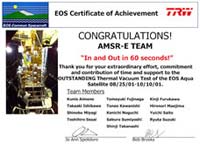Topics List
Dec. 2, 2013 Updated
AMSR-E Slow Rotation Data has been released
|
The AMSR-E automatically halted its observations and rotation on October 4, 2011 (UTC) due to increased rotation friction. After then NASA and JAXA began to analyze the situation and had been seeking for the way to restart AMSR-E observation. And on December 4, 2012 (UTC,) the AMSR-E restarted its observations and rotation with slow rotation (2 rotations per minute). JAXA completed initial radiometric and geometric correction for slow rotation data, and now AMSR-E Slow Rotation Data is available to public users. image: Observed area with slow rotation The detail is described in the following page. |
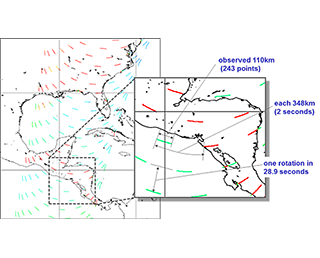
|
|---|
Oct. 4, 2011 Updated
AMSR-E observation halted
|
JAXA has been operating the Advanced Microwave Scanning Radiometer-EOS (AMSR-E) for over nine years (despite a design life of three years) as an onboard device installed in the American earth observation satellite Aqua, after its launch on May 4, 2002. It has been contributing accuracy improvement of weather forecasts, compiling ocean condition information for fishing, and understanding the impact of global warming in the field of water circulation and climate change. |
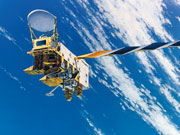 |
|---|
May 18, 2006 Updated
AMSR-E data for the global numerical prediction model by the Japan Meteorological Agency
|
On May 15, 2006, the Japan Meteorological Agency started to use data acquired by onboard microwave radiometer sensors on satellites, including the AMSR-E, the Japanese sensor aboard the NASA satellite AQUA, for the global numerical prediction model. 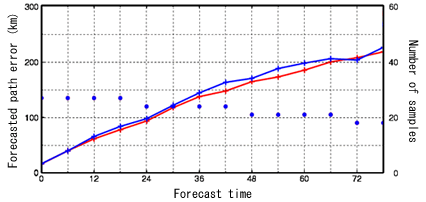 Figure 1: Forecast errors of the center paths of Typhoons No. 11 to 18 in 2004 (Provided by the Japan Meteorological Agency)
 Figure 2: Microwave radiometer data distribution example (provided by the Japan Meteorological Agency) Green: AQUA, Blue: TRMM (Tropical Rainfall Measuring Mission), Red: DMSP 13, Orange: DMSP 14, Purple: DMSP 15 (US military meteorological satellites)
|
|
|---|
Nov. 29, 2004 Updated
AMSR-E data for weather forecasts
|
The Japan Meteorological Agency started using data from AMSR-E for its weather forecasting operations on Nov. 17, 2004. In recent years, the most commonly used forecasting method is numerical weather predictions by reproducing the atmospheric movements on a computer. The accuracy of the numerical weather prediction heavily depends on the quality and quantity of observation data and numerical models. Data from a satellite is very important input information for the predictions because a satellite can acquire homogenous data from the vast ocean areas which are otherwise very difficult to observe. 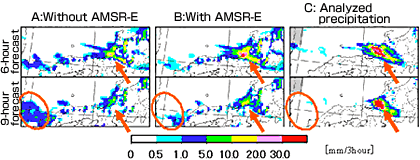 The above images are six- and nine-hour forecasts at 3:00 p.m. on July 18, 2004 (Japan time). A and B are forecast results with and without AMSR-E respectively, and C shows actual precipitation. With AMSR-E, estimated rain strength (indicated by an orange arrow) is closer to actual precipitation, thus forecast accuracy is obviously improved. Without AMSR-E, the forecasted area of precipitation is extended to the offshore of Yamaguchi Prefecture (indicated by an orange oblong), but the area gets smaller with AMSR-E. Analysis and forecast results were provided by the Japan Meteorological Agency. |
May 10, 2004 Updated
AQUA smoothly continues observations for two years.
|
The NASA earth observation satellite, AQUA, on which our Advanced Microwave Scanning Radiometer-EOS (AMSR-E) is aboard, celebrated its second anniversary on May 4, 2004. AMSR-E continues its smooth observations to provide global physical volume data (please refer to the images.) In these two years, it acquired data on the first El Nino phenomenon in the 21st century (*1) and the heat wave in Europe in the summer of 2003 (*2). It also started to distribute data on eight products, including soil moisture, in March 2004 (*3). This data can be acquired through the website of the Earth Observation Center. (*4) |
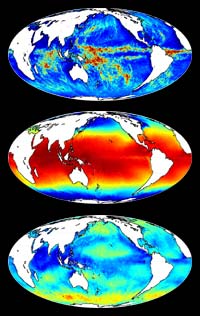 |
|---|
Jan. 7, 2004 Updated
New site is open for latest information of floating ice in the Sea of Okhotsk.
Sea ice concentration data acquired by AMSR-E are updated everyday.
|
The Earth Observation Research and Application Center (EORC) started the new site to provide updated data about floating ice of the Sea of Okhotsuk. The data are mainly acquired by the Advanced Microwave Scanning Radiometer-EOS (AMSR-E) of "Aqua", a NASA satellite. AMSR-E was developed by NASDA, one of the JAXA's predecessor organizations, and launched in May 2002 as one of the onboard equipment of "Aqua". AMSR-E has been working well since its launch. |
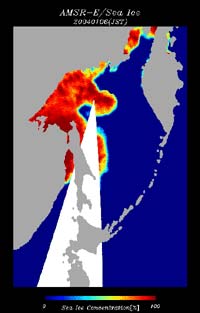 |
|---|
Sep. 22, 2003 Updated
The AMSR-E project started to provide "geophysical products".
|
The Advanced Microwave Scanning Radiometer for EOS (AMSR-E), which is one of the observation equipment of NASA's satellite, Aqua, is a sensor developed by NASDA to observe global water. The AMSR-E is carrying out the observation smoothly for a year and four months since its launch. On Sep. 19, we started to provide "geophysical products" followed by "brightness temperature products" that have been open to the public since June this year. Five geophysical parameters, namely sea surface temperature, sea surface wind speed, integrated water vapor, precipitation, and sea ice concentration, are provided to domestic and overseas research institutes and general users. The geophysical products are generated by combining brightness temperature data acquired through multiple observation frequencies and include user friendlier parameters. They will be used for understanding global scale water and energy circulations. For products and data, please check the following website. |
 |
|---|
Jan. 10, 2003 Updated
AMSR-E Level 3 Global Browse Images released
|
Advanced Microwave Scanning Radiometer for EOS (AMSR-E) a microwave radiometer newly developed by NASDA for the observation of geophysical parameters mainly relevant to water on the Earth, has been successfully working onboard the NASA's earth observation satellite Aqua. |
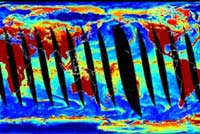 |
|---|
Sep. 18, 2002 Updated
|
After an investigation into telemetry anomaly on the AMSR-E aboard the EOS-PM1 (Aqua) in orbit, which was launched on May 4, 2002, it was confirmed that these problems would not effect future operations. In addition, the initial checkout in orbit was completed on the AMSR-E and the satellite moved into normal orbital operations. From now on, calibration and validation of observed data, function and performance verification on ground data processing systems and the processing program development to estimate the physical quantity from observed data will be completed. The observed data will be publicized in May 2003, one year after the launch. |
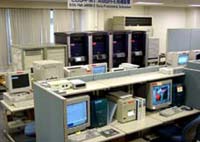 |
|---|
May 4, 2002 Updated
|
NASA's Earth observation satellite "Aqua" (formerly named EOS-PM), which carries NASDA's microwave radiometer AMSR-E, was successfully launched by a Delta II rocket at 2:54:58 (PDT) on May 4, 2002, from the Vandenberg Launch Site in California. As scheduled, the Aqua spacecraft successfully separated from the Delta II rocket on its first orbit at 3:54 (PDT), and AMSR-E was powered on at 4:50 (PDT) on May 4. |
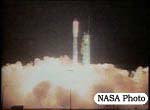 |
|---|
Apr. 30, 2002 Updated
|
After the delivery of the AMSR-E to NASA in Los Angeles in December 1999, the spacecraft integration and test has been performed there since January 2000 and it has been completed this time. |
 |
|---|
Mar. 1, 2002 Updated
|
After the delivery of the AMSR-E to NASA in Los Angeles in December 1999, the spacecraft integration and test has been performed there since January 2000 and it has been completed this time. |
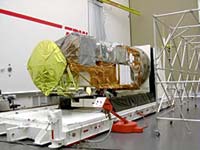 |
|---|
Jan. 30, 2002 Updated
|
After the delivery of the AMSR-E to NASA in Los Angeles in December 1999, the spacecraft integration and test has been performed there since January 2000. |
 |
|---|
Dec. 26, 2001 Updated
|
After the delivery of AMSR-E to NASA in Los Angels in December 1999, the spacecraft integration and test has been performed there since January 2000. |
Jul. 30, 2001 Updated
After the delivery of AMSR-E to NASA in Los Angels in December 1999, the spacecraft integration and test has been performed there since January 2000. In July, SCPT (System level Comprehensive Performance Test) #2 was performed. The thermal vacuum test is scheduled from August to September.
Jun. 13, 2001 Updated
After the delivery of AMSR-E to NASA in Los Angeles in December 1999, the spacecraft integration and test has been performed there since January 2000. In May, the fault Management test and the fourth SCIF (Spacecraft interface) test were also performed.
NASA has postponed the launch schedule of EOS-PM1(Aqua) from July 2001 to December 2001.
Apr. 3, 2001 Updated
After the delivery of AMSR-E to NASA in Los Angels in December 1999, the spacecraft integration and test has been performed there since January 2000. The third SCIF (Spacecraft interface) test was performed in March.
Mar. 15, 2001 Updated
After the delivery of AMSR-E to NASA in Los Angels in December 1999, the spacecraft integration and test has been performed there since January 2000. The first SCPT (System level Comprehensive Performance Test) was performed from February to March. The third SCIF (Spacecraft interface) test is scheduled in March.
Feb. 5, 2001 Updated
|
After the delivery of AMSR-E to NASA in Los Angels in December 1999, the spacecraft integration and test has been performed there since January 2000. The SCIF (Spacecraft Interface) test was performed in January. This test was to control the spacecraft in Los Angels from NASA/GSFC (Goddard Space Flight Center, in Maryland). The interface test regarding AMSR-E was performed well. The System Level CPT (Comprehensive Performance Test) prior to the thermal vacuum test is scheduled in February. |
 |
|---|
Jan. 15, 2001 Updated
After the delivery of AMSR-E to NASA in Los Angels in December 1999, the spacecraft integration and test has been performed there since January 2000. The CPT (comprehensive performance test) after the mechanical environmental tests was performed well in December. The System Level CPT prior to the thermal vacuum test will be performed in January.
Dec. 8, 2000 Updated
|
After the delivery of AMSR-E to NASA in Los Angels in December 1999, the spacecraft integration and test has been performed there since January 2000. The mechanical environmental tests (the acoustic test, the vibration test and the shock test) were performed well in November. The CPT (comprehensive performance test) after the mechanical environmental tests will be performed in December. |
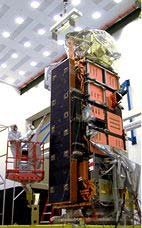 |
|---|
Nov. 2, 2000 Updated
|
AMSR-E before the EMC test (after the main reflector was rotated at 90 degrees) |
 |
|---|
Sep. 14, 2000 Updated
|
AMSR-E on the spacecraft |
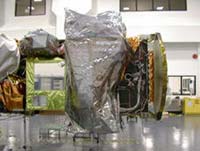 |
|---|
Jun. 30, 2000 Updated
|
AMSR-E on the spacecraft |
 |
|---|
Apr. 14, 2000 Updated
|
AMSR-E before the delivery to NASA |
 |
|---|
Jan. 14, 2000 Updated
|
The system test for the final stage of the development of AMSR-E was completed in early December. In the middle of December, AMSR-E was shipped to TRW in Los Angels that is developing NASA's spacecraft EOS-PM1. |
 |
|---|
Dec. 10, 1999 Updated
|
The system test for the final stage of the development has been conducted at Tsukuba Space Center. AMSR-E will be launched in the state of the antenna folded to put AMSR-E into the rocket fairing and the antenna will be deployed after the spacecraft is put into the orbit. Therefore, the antenna deployment mechanism has very important role. In November the antenna deployment test was conducted after the vibration test. It was verified that the mechanism functions properly. The deployment test this time is the same test as the one conducted in August after the thermal-vacuum test and the acoustic test. |
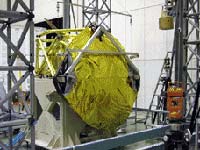 |
|---|
Nov. 12, 1999 Updated
|
The system test for the final stage of the development has been conducted at Tsukuba Space Center and at the maker. The vibration test was performed to verify that AMSR-E has sustained no damage after the exposure to the vibration imposed by the launch vehicle in October. It was verified that AMSR-E had no damage. |
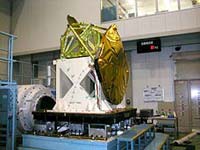 |
|---|
Sep. 10, 1999 Updated
|
The system test for the final stage of the development has been conducted at Tsukuba Space Center. The acoustic test was performed to verify that AMSR-E has sustained no damage after being exposed to the acoustic vibration imposed by the launch vehicle in July. It was verified that AMSR-E had no damage. |
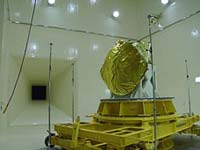 |
|---|
Jul. 26, 1999 Updated
|
The system test which is the final stage of the development is being performed at Tsukuba Space Center. The thermal vacuum test was performed to verify the AMSR-E function in the severe space environment in June and the function of AMSR-E was confirmed. |
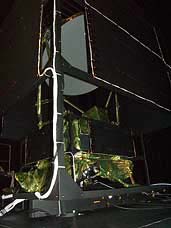 |
|---|
